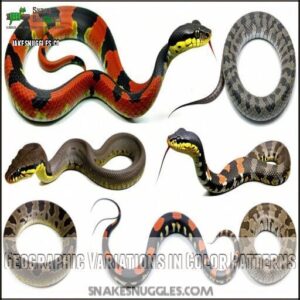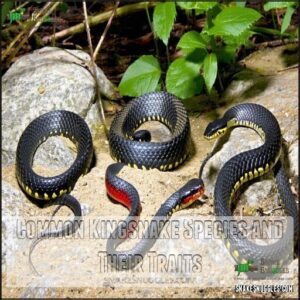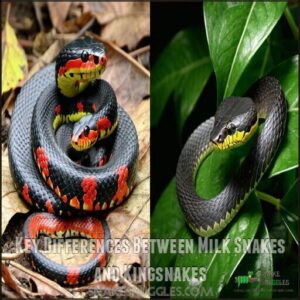This site is supported by our readers. We may earn a commission, at no cost to you, if you purchase through links.

Milk snakes typically have red, black, and white or yellow bands, arranged in a pattern that mimics venomous coral snakes, while kingsnakes show more variety, from stripes to blotches.
Size-wise, they’re similar, usually 2 to 5 feet long, but kingsnakes tend to be bulkier.
Behaviorally, both are docile, though kingsnakes are famous for eating other snakes, even venomous ones.
Milk snakes often prefer cooler, moist habitats, while kingsnakes adapt to a broader range.
Curious about which makes the better pet? There’s more to ponder!
Table Of Contents
- Key Takeaways
- Are Milk Snakes Kingsnakes
- What Are Milk Snakes and Kingsnakes
- Physical Characteristics of Milk Snakes
- Physical Characteristics of Kingsnakes
- Milk Snakes Vs Kingsnakes Size and Habitat
- Behavior and Temperament of Milk Snakes
- Behavior and Temperament of Kingsnakes
- Milk Snakes and Kingsnakes as Pets
- Key Differences Between Milk Snakes and Kingsnakes
- Choosing Between Milk Snakes and Kingsnakes
- Frequently Asked Questions (FAQs)
- How Big Can Milk Snakes and Kingsnakes Grow?
- Are Milk Snakes and Kingsnakes Venomous?
- Are There Any Special Care Requirements for Milk Snakes and Kingsnakes?
- Are Milk Snakes and Kingsnakes Found in the Same Geographic Locations?
- Are milk snakes venomous?
- How do you identify a milk snake and a kingsnake?
- Are kingsnakes venomous?
- Are kingsnakes and milk snakes the same?
- What are the different types of milk snakes?
- Are milk snakes constrictors?
- Conclusion
Key Takeaways
- You’ll find milk snakes and kingsnakes share the same genus, but milk snakes mimic venomous coral snakes with their tri-colored bands, while kingsnakes come in diverse patterns like stripes and blotches.
- Both snakes are nonvenomous constrictors, making them harmless to humans and beginner-friendly pets, but kingsnakes are bulkier and more adaptable to different habitats.
- Milk snakes prefer cooler, moist environments while kingsnakes thrive in a wider range, including deserts and lowlands, showing impressive versatility.
- Kingsnakes are confident and easier to handle, while milk snakes can be shy and skittish at first but calm down with regular, gentle handling.
Are Milk Snakes Kingsnakes
Milk snakes are a specific type of kingsnake, as both belong to the genus Lampropeltis.
While all milk snakes are kingsnakes, not all kingsnakes are milk snakes, giving each group its own unique traits.
Taxonomic Classification and Relationship
In the context of snake classification, milk snakes and kingsnakes share an incredible taxonomic relationship. Both belong to the genus Lampropeltis, meaning "shiny shield," highlighting their glossy scales.
To clear up confusion: all milk snakes are kingsnakes, but not all kingsnakes are milk snakes.
Their diversity is remarkable, with milk snakes classified under the species Lampropeltis triangulum, boasting 24 subspecies. Kingsnakes, on the other hand, encompass over 45 distinct species.
Here’s what’s fascinating:
- Genetic similarity lets them interbreed with other kingsnake species.
- Their tricolor classification shows evolutionary adaptability.
- Subspecies variation reveals regional differences.
Together, they create a vivid picture of complex snake taxonomy and evolutionary brilliance.
Shared Physical Characteristics
Milk snakes and kingsnakes share some dazzling physical traits that make them stand out in the snake world.
Their smooth, glossy scales shimmer in light, giving them a polished look. In terms of banded patterns, both snake species showcase striking combinations of colors, though milk snakes often mimic venomous coral snakes.
In a snake species comparison, their body shape is sleek and designed for easy movement, with adult size typically ranging between 2–6 feet.
Milk snake vs kingsnake identification becomes easier by focusing on differences in scale texture, patterns, and natural color morphs, helping you distinguish these fascinating reptiles.
King snakes, however, possess rougher, more distinct scales, which is a key factor in species comparison.
What Are Milk Snakes and Kingsnakes
Milk snakes and kingsnakes are nonvenomous reptiles belonging to the Lampropeltis genus, known for their smooth, glossy scales and striking color patterns.
Smooth, glossy scales and bold patterns make milk snakes and kingsnakes true marvels of the Lampropeltis genus.
While milk snakes are a type of kingsnake, these two groups include many subspecies with unique traits and behaviors.
Unique Color Patterns and Morphology
Snake patterns are fascinating, offering insights into their lives and survival strategies.
Milk snake colors and kingsnake patterns shine as both species boast unique, eye-catching looks. Their morphology includes smooth, glossy scales that amplify their natural vibrance.
- Milk snakes flaunt tri-colored bands—red, black, and white or yellow, using banding mimicry to resemble venomous coral snakes.
- Kingsnakes showcase diverse patterns like stripes, blotches, or solid colors, reflecting regional coloration.
- Pattern genetics influence their morph variations, creating endless stunning combinations in the wild and captivity.
- Milk snake morphology features consistent, repeating bands, while kingsnakes often vary more dramatically.
These mesmerizing snakes truly redefine natural artistry!
Size Comparison Between Milk Snakes and Kingsnakes
A big difference between milk snake size and kingsnake size is their maximum length.
Milk snakes average 2-4 feet, with a maximum size around 6 feet, making them slender and compact.
Kingsnakes are bulkier, averaging 3-6 feet but reaching up to 8 feet.
Regional variations and captive growth also influence their scale count and body proportions.
Milk snakes are great for beginners, while kingsnakes’ larger size suits experienced keepers seeking more presence.
Physical Characteristics of Milk Snakes
Milk snakes are known for their smooth, glossy scales and distinctive tri-colored bands, typically featuring red, black, and yellow or white.
These patterns serve both as a form of mimicry to deter predators and make them visually striking.
Smooth and Glossy Scales
Milk snakes are known for their smooth scales that gleam like polished glass, catching light beautifully—a standout in snake identification.
Their scale texture is glossy and seamless, making them masters at traversing tight spaces.
This smoothness also aids in conserving body heat.
Unlike snakes with keeled scales, milk snakes boast unmatched scale iridescence after shedding.
In captive breeding, their shimmering appearance and distinctive scale morphology make them a favorite, distinguishing them easily from kingsnake characteristics, with a notable smooth scales feature and overall glossy texture.
Tri-Colored Banding Arrangement
Three-colored banding on milk snakes is a natural masterpiece. You’ll notice red, black, and white (or yellow) rings, but their stunning look isn’t just for show. They’re experts in Batesian mimicry, resembling venomous coral snakes to deter predators.
When identifying milk snakes, focus on:
- Color Order: Red touches black, not yellow like coral snakes.
- Band Thickness: Rings are uniform in size, wrapping the body fully.
- Mimicry Accuracy: Patterns create confusion for predators.
- Morphs Influence: Breeding enhances milk snake colors and design.
These traits make distinguishing snakes easier and fascinating!
Geographic Variations in Color Patterns
If you’ve seen milk snakes in different places, you might’ve noticed how their colors and patterns shift.
These regional colorations are influenced by habitat, genetic drift, and their need to adapt.
For example:
| Region | Pattern Adaptation | Mimicry Variations |
|---|---|---|
| Florida | Red, black, and yellow bands | Mimic venomous coral snakes |
| Michigan | Gray base with rusty-red blotches | Camouflages in rocky habitats |
| New Mexico | Desert-like browns and creams | Blends with arid environments |
Their milk snake colors reflect the kingsnake habitat diversity, ranging across North and Central America.
These color morphs make exploring their geographical range fascinating!
Physical Characteristics of Kingsnakes
Kingsnakes are known for their smooth, glossy scales and striking color patterns, which vary widely across species.
They can range from solid black to bold, banded designs, making them one of the most visually diverse snakes.
Common Kingsnake Species and Their Traits
Among kingsnake species, each brings something unique to the table.
The California Kingsnake is famous for bold, banded patterns, while the Scarlet Kingsnake displays tricolored bands mimicking coral snakes.
The Desert Kingsnake has delicate yellow flecks, perfect for camouflage. The Florida Kingsnake, with speckled or striped patterns, thrives in swampy areas, and the Speckled Kingsnake flaunts a glittery, dotted look.
These Lampropeltis species thrive in diverse habitats, showing remarkable adaptability.
Known for intriguing kingsnake behavior, they confront prey with agility and strength—whether in the wild or your care, they’re fascinating companions demanding proper enclosures mimicking natural kingsnake habitats.
Variation in Color Patterns and Morphology
Kingsnakes are intriguing for their endless color morphs and patterns, showcasing nature’s ability to adapt.
Their scale patterns and banding variations reflect regional differences and survival strategies, often mimicking venomous snakes for protection.
- Scarlet kingsnakes feature bright red, black, and yellow bands, resembling coral snakes.
- Desert kingsnakes lean in the direction of muted, sandy tones, blending with arid habitats.
- California kingsnakes display both banded and striped patterns, adding diversity.
- Mountain kingsnakes dazzle with red, black, and white combinations, suiting higher elevations.
- Florida kingsnakes stand out with speckled patterns of yellow or brown.
These snakes’ banded patterns and hybrid morphology make them a fascinating contrast to their cousins, milk snakes.
Comparison With Milk Snake Characteristics
Milk snakes and kingsnakes share impressive diversity, but their differences stand out.
Milk snake colors often feature vivid tricolor bands—red, black, and yellow or white—designed for banding mimicry to resemble venomous coral snakes.
Kingsnakes have more varied patterns, from bold stripes to solid colors.
If you’re examining scale texture, milk snakes boast smoother, glossier scales compared to the slightly textured appearance of kingsnakes.
Milk snakes also have a slender head, while kingsnakes show broader, blockier heads.
These traits simplify milk snake identification versus their kingsnake relatives.
Milk Snakes Vs Kingsnakes Size and Habitat
You’ll notice milk snakes and kingsnakes differ in size, with milk snakes typically growing 2 to 4 feet and kingsnakes reaching up to 6 feet.
Their habitats overlap in diverse environments, from forests and grasslands to rocky areas, showcasing their adaptability.
Geographic Distribution and Habitat Preferences
Stretching across vast regions—from Canada to South America’s northernmost areas—milk snakes and kingsnakes are masters of adaptation.
Their overlapping habitats reveal shared survival strategies while highlighting unique preferences shaped by regional variations.
Here’s a quick comparison of their geographic traits:
| Species | Milk Snake Range & Habitat | Kingsnake Range & Habitat |
|---|---|---|
| Diversity | Woodlands, forests, barns, swamps | Grasslands, deserts, streams |
| Geographic Range | Americas: North, Central, South | North America |
| Altitude | Up to 8,000 feet | Primarily lowlands |
| Climate | Temperate, subtropical climates | Temperate, arid |
| Behavior | Seasonal migration, occasional overlap | Prefers lowland, fossorial spaces |
Milk snakes occupy forests, rocky areas, or agricultural lands, often reaching elevations kingsnakes bypass.
Kingsnakes stick closer to lowland streams, deserts, and grasslands.
Despite their differences, both reptiles display impressive climate adaptation, thriving in temperate to arid ecosystems.
Whether beneath rocks or in hidden suburban nooks, these snakes play essential ecosystem roles, aiding rodent control, which benefits conservation efforts overall.
Adaptation to Different Environments
You’ll find these snakes everywhere, from deserts to lush forests, thanks to their remarkable adaptability.
Their habitats and traits shift based on the environment they call home:
| Environment | Adaptation |
|---|---|
| Desert | Light scales; nocturnal activity |
| Forest | Darker bands; semi-arboreal behaviors |
| Wetlands | Moisture-resistant scales; swimming skill |
| Grasslands | Quick movement; prey-rich zones |
This habitat diversity and climate tolerance guarantee their survival across regions.
Some kingsnakes, known for their stouter body types, thrive in these diverse habitats across the Americas.
Their ecological niche reflects clever survival strategies, adjusting seamlessly to prey availability and environmental challenges.
Behavior and Temperament of Milk Snakes
Milk snakes are generally calm and tolerate handling well, making them a popular choice for pet owners.
In the wild, they’re nocturnal hunters known for their agility and unique defensive mechanisms, like mimicking venomous coral snakes to deter predators, which showcases their remarkable defensive mechanisms.
Typical Milk Snake Behavior in The Wild
Milk snakes exhibit fascinating behaviors that highlight their adaptability in the wild.
Milk snakes showcase incredible adaptability, mastering nocturnal hunting, climbing, and mimicry to thrive in diverse environments.
Here’s a closer look at their natural habits:
- Nocturnal Hunting: These snakes are most active during dawn and dusk, using sharp senses to hunt.
- Climbing Skills: Known as skilled climbers, they navigate trees, rocks, and other terrain with ease.
- Communal Brumation: In winter, they gather in groups to brumate in protected spaces like burrows.
- Wild Diet: Milk snakes are opportunistic feeders, preying on small mammals, birds, reptiles, and eggs.
Understanding milk snake behavior provides essential insights into how they thrive across diverse snake habitats while employing mimicry defense and practical survival techniques.
Defensive Mechanisms and Responses to Threats
In the context of clever snake defense mechanisms, milk snakes are masters of disguise.
They utilize defensive mimicry, shaking their tails to copy rattlesnakes’ sound and flattening their heads to appear larger.
Their colorful bands employ Batesian mimicry, resembling venomous coral snakes to deter predators.
If that fails, they release a strong musky odor as a last-ditch effort.
While milk snakes may strike defensively, they lack venom, relying on their immune system’s venom immunity and bluffing tactics to stay safe.
These behaviors showcase how adaptable and resourceful milk snakes are in protecting themselves from predators.
Handling Milk Snakes: Best Practices and Precautions
Handling milk snakes is simple with care and attention.
Support their entire body and approach calmly to reduce stress.
- Scoop from below using a gentle touch.
- Keep handling sessions short to prevent stress.
- Practice hygiene: wash hands before and after handling.
Safe handling guarantees happy, healthy milk snakes!
A proper setup should include secure hiding spots to minimize stress.
Behavior and Temperament of Kingsnakes
Kingsnakes are generally calm and docile, making them suitable for handling.
They may display defensive behaviors like tail shaking and musking when they feel threatened.
They’re skilled hunters with a unique diet that includes rodents, reptiles, and even venomous snakes, thanks to their immunity to snake venom.
Kingsnake Defensive Behaviors and Aggression Levels
Kingsnakes have fascinating defensive mechanisms to keep threats at bay.
They mimic rattlesnakes with tail vibration, flatten their heads to appear aggressive, and release a musky odor if cornered.
Though generally docile, they might strike when stressed.
These escape artists rely on head hiding and coiling when frightened.
Here’s a quick glance:
| Trait | Purpose |
|---|---|
| Tail Vibration | Mimics rattlesnakes |
| Head Flattening | Feigns aggression |
| Musky Odor Release | Deters predators |
| Body Coiling | Self-protection |
| Escape Artistry | Avoids confrontation |
Kingsnake Dietary Habits and Prey Preferences
Kingsnakes are fascinating predators with impressive dietary adaptations that show their opportunistic feeding nature.
These snakes, known as ophiophages, even prey on venomous species, thanks to their immunity to snake venom. They’re excellent hunters, using powerful constrictions to subdue prey before swallowing it whole.
Juvenile diets typically consist of smaller meals, including lizards and pinky mice.
As adults, kingsnakes tackle a wider variety of prey:
- Rodents like mice and rats, providing protein-packed nutrition.
- Other snakes, showcasing their ability as natural pest controllers.
- Frogs and amphibians around wetlands or forests.
- Turtle eggs, an opportunistic addition to their versatile diet.
Understanding the kingsnake diet helps guarantee proper care for these remarkable creatures.
Kingsnakes’ diets are also influenced by seasonal prey availability.
Interaction With Humans: Temperament and Handling
Kingsnakes are known for their docile nature, making them suitable even for beginners.
Their temperament improves with regular, gentle handling, so take your time earning their trust.
Pay attention to stress signals like tongue flicking or attempts to hide. Always support their body to prevent injury or distress.
With proper snake handling techniques, these snakes are calm companions, posing minimal bite risk and offering excellent training potential, even around children.
Milk Snakes and Kingsnakes as Pets
If you’re considering a pet snake, both milk snakes and kingsnakes are excellent choices due to their docile nature and manageable care requirements.
These nonvenomous species thrive in captivity, needing simple enclosures, consistent temperatures, and a diet of appropriately sized prey.
Popularity and Suitability as Pet Snakes
Thinking about milk snakes or kingsnakes as pet snakes? Both are beginner-friendly and offer enjoyable companionship.
Their temperament is calm, making handling easy for all experience levels. These gentle reptiles also adapt well to captivity.
Here’s why they’re popular:
- Small enclosures suit their manageable size.
- Color morphs cater to personal style preferences.
- Low-maintenance care fits busy lifestyles.
- Handling ease fosters bonding and trust.
- Temperament differences offer variety for enthusiasts.
Whether you admire their looks or their low upkeep, these snakes shine as rewarding pets.
Care Requirements: Habitat, Diet, and Maintenance
Creating the ideal setup for milk snake care and kingsnake care is simple when you focus on their needs.
Key care essentials:
- Enclosure Size and Setup: Choose a snake enclosure with secure locks, proper ventilation, and at least two hideouts. Substrate choices like aspen shavings or coconut fiber work well.
- Temperature Gradient and Humidity Levels: Maintain a warm gradient of 75-85°F with a cooler side and 30-60% humidity. Use a heat mat or lamp for precise control.
- Feeding Frequency: Offer small, thawed mice every 7-14 days. Adjust portions based on your snake’s size.
Clean the habitat regularly, provide fresh water, and handle gently to build trust. A proper habitat includes a suitable milk snake enclosure.
Meeting these essentials guarantees happy, thriving snakes!
Health Considerations for Captive Milk and Kingsnakes
Your milk snake or kingsnake’s health relies on proper care. Keep their captive environment at 75-85°F with 40-60% humidity to prevent respiratory issues.
Watch for shedding problems or parasites by checking their scales regularly. Maintaining a clean habitat requires specialized cleaning supplies.
Maintain enclosure hygiene and feed a balanced diet to avoid nutritional deficiencies. Clean, fresh water is essential daily.
Gentle handling builds trust, but always wash your hands first. Regular vet visits guarantee early detection of snake diseases and peak snake health.
Key Differences Between Milk Snakes and Kingsnakes
Milk snakes and kingsnakes may look similar at first, but their differences go beyond just color patterns and size.
Understanding these key distinctions helps you appreciate how these fascinating snakes adapt to their unique environments and behaviors, which is a fascinating aspect of their biology, and learning about their unique environments can be very insightful.
Coloration Patterns and Morphology
When comparing coloration patterns, morphology differences are clear between these snakes.
Milk snakes feature tricolor bands—red, black, and yellow or white—perfect for pattern mimicry, imitating coral snakes.
Kingsnakes have more varied color morphs, including bold band arrangements or even solid colors.
Their smoother scale texture gives milk snakes an edge in appearance, while size dimorphism also affects their aesthetics.
Size and Geographic Distribution
Milk snakes and kingsnakes showcase fascinating size variation and adaptability across their vast geographical range.
Milk snakes, stretching across North and South America, span from Canada to Ecuador. Kingsnakes, meanwhile, thrive in the southern U.S. and Mexico, often sharing habitats with milk snakes.
- Habitat overlap: Both species inhabit forests, grasslands, and even deserts.
- Regional adaptations: Tropical milk snakes tend to grow larger than those in temperate zones.
- Distribution factors: Their widespread presence highlights these snakes’ ability to thrive in diverse ecosystems, emphasizing their ecological importance.
Behavior and Temperament
Milk snakes and kingsnakes each have unique temperaments and activity patterns.
Milk snakes are calm but may seem skittish initially, while kingsnakes might show defensive behaviors like tail shaking.
Regular handling helps build trust and minimize aggression. Recognizing snake behavior cues is key for safe handling.
Both species display docility levels suited for captivity, but careful handling techniques guarantee a stress-free experience.
Choosing Between Milk Snakes and Kingsnakes
If you’re deciding between a milk snake and a kingsnake as a pet, you’ll want to take into account their size, temperament, and care needs.
Both species are nonvenomous and relatively low-maintenance, but subtle differences can help you choose the right fit for your experience level.
Factors to Consider for Pet Ownership
Thinking of adding a fascinating pet snake to your home? Milk snakes and kingsnakes are excellent choices, but it’s important to weigh a few key factors:
- Cost Analysis: Captive-bred pet snakes typically cost $50 to $200, while rare morphs can surpass $1,000.
- Enclosure Needs: Plan for an enclosure accommodating their adult length (3–6 feet) and make certain secure lids—they’re escape artists!
- Handling Ease and Temperament: Both species are beginner-friendly, though milk snake care may require extra patience since young milk snakes can be skittish.
Budgeting for kingsnake ownership costs is vital. Choose carefully to provide the right environment and experience for your scaly companion.
Comparison of Care Requirements and Temperament
When choosing between these snakes, their care and temperament make a difference.
Kingsnakes adapt readily, while milk snakes like snug hides to feel secure. Humidity needs vary: kingsnakes thrive at 40–60%, but milk snake care involves maintaining 60–70%.
Both enjoy moderate enclosure size and are non-venomous, though kingsnakes tend to handle better due to their confidence.
| Key Factor | Milk Snakes | Kingsnakes |
|---|---|---|
| Handling Differences | Shy, may hide | Confident, outgoing |
| Enclosure Size | Moderate | Moderate |
| Feeding Frequency | Weekly | Weekly |
| Humidity Needs | 60–70% | 40–60% |
| Temperament | Shy, docile | Bold, docile |
Recommendations for Beginners and Experienced Owners
For first-time owners, milk snakes are an excellent pick, thanks to their manageable size and calm temperament.
Kingsnakes, however, suit those ready for a snake with a bit more personality.
Here are tips for both milk snake care and kingsnake care:
- Choose captive-bred snakes from a trusted breeder for ease of care.
- Set up a secure, escape-proof enclosure with enrichment like hides and branches.
- Handle lightly to build trust without causing stress.
- Explore dietary variety such as frozen-thawed prey.
- Research advanced morphs if you’re an experienced keeper.
Frequently Asked Questions (FAQs)
How Big Can Milk Snakes and Kingsnakes Grow?
Ever wonder how big these beauties get? Milk snakes typically grow 2–4 feet, sometimes up to 7 feet, while kingsnakes average 3–6 feet. Their manageable size makes them great for herpetology enthusiasts.
Are Milk Snakes and Kingsnakes Venomous?
Milk snakes and kingsnakes aren’t venomous.
They’re harmless constrictors, using their strength to subdue prey like rodents and other animals.
Despite their striking patterns, they’re perfectly safe for humans and popular as docile pets.
Are There Any Special Care Requirements for Milk Snakes and Kingsnakes?
Both milk snakes and kingsnakes are low-maintenance pets but need secure enclosures to prevent escapes.
Proper humidity, heat gradients, and regular feeding are also necessary for their care.
Handle them gently, make certain fresh water is available, and clean their habitats regularly.
Are Milk Snakes and Kingsnakes Found in the Same Geographic Locations?
Isn’t it fascinating how nature overlaps?
Milk and kingsnakes often cross paths, sharing habitats like forests, grasslands, and swamps across North and South America.
You’ll find them coexisting, each thriving in similar environments yet distinct.
They share these habitats, from forests to swamps, across both North and South America.
Are milk snakes venomous?
They’re not venomous, so don’t worry about getting bitten.
Milk snakes use constriction to subdue their prey.
Their bright colors mimic venomous snakes like coral snakes, fooling predators into thinking they’re dangerous when they’re harmless.
How do you identify a milk snake and a kingsnake?
Spotting the difference is like cracking a colorful code—milk snakes have red, black, and yellow or white bands, mimicking coral snakes.
While kingsnakes show more variety, including solid colors, stripes, and banding.
Are kingsnakes venomous?
Kingsnakes aren’t venomous; they’re constrictors.
They kill their prey by squeezing instead of using venom.
Despite their intimidating name, they’re harmless to humans and make great pets thanks to their calm temperament and striking patterns.
Are kingsnakes and milk snakes the same?
It’s easy to think kingsnakes and milk snakes are the same since milk snakes are a type of kingsnake.
But not all kingsnakes are milk snakes—they’re just one subspecies out of many within the genus Lampropeltis.
What are the different types of milk snakes?
Milk snakes include 25 subspecies, such as Eastern, Honduran, Nelson’s, Pueblan, and Mexican milk snakes.
Each has unique patterns and colors, usually red, black, and yellow or white bands, mimicking venomous coral snakes.
Are milk snakes constrictors?
Think of a skilled dancer wrapping their partner; milk snakes are constrictors.
They coil around prey, squeezing tightly until it can’t breathe.
It’s nature’s version of a hug—just not the friendly kind!
Conclusion
Deciding between milk snakes and kingsnakes can feel like choosing between two beautifully wrapped gifts.
Both are stunning, manageable, and docile, but each has unique traits.
Milk snakes dazzle with their coral snake mimicry and thrive in cooler habitats, while kingsnakes adapt broadly and even eat venomous snakes.
Consider their size, care needs, and temperaments when selecting, whether fascination with vivid colors or adaptability draws you, understanding these differences guarantees the right match for your reptile journey.




















